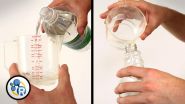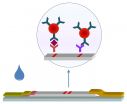Study: Gene therapy superior to half-matched transplant for 'bubble boy disease'
Research first to compare alternative approaches to fully matched transplant for rare immune disorder
2015-04-13
(Press-News.org) (WASHINGTON - April 13, 2015) - New research published online today in Blood, the Journal of the American Society of Hematology (ASH), reports that children with "bubble boy disease" who undergo gene therapy have fewer infections and hospitalizations than those receiving stem cells from a partially matched donor. The research is the first to compare outcomes among children with the rare immune disorder - also known as X-linked severe combined immunodeficiency (SCID-X1) - receiving the two therapeutic approaches.
Children with SCID-X1 are born with a genetic defect that prevents them from developing a normal immune system. Because they are prone to life-threatening infections, infants with SCID-X1 must be kept in a sterile, protective bubble and require extensive treatment for survival beyond infancy. Infants with SCID are most likely to survive if they receive a stem cell transplant from a fully matched donor - typically a sibling - a procedure that replaces an infant's diseased stem cells with healthy donor cells. Following a successful fully matched transplant, infants with SCID-X1 are able to produce their own immune cells for the first time.
In the absence of a fully matched stem cell donor, infants with SCID-X1 may receive a transplant from a partial, or "half-matched," donor - typically their mother or father. They may also undergo gene therapy, a much different approach. Gene therapy for SCID-X1 involves extracting an infant's own bone marrow, using a virus to replace faulty genetic material with a correct copy, and then giving "corrected" bone marrow back to the patient. Half-matched stem cell transplant and gene therapy represent secondary treatment approaches for infants with SCID-X1. Until recently, researchers had not yet compared outcomes among children treated with each respective approach.
"Over the last decade, gene therapy has emerged as a viable alternative to a partial matched stem cell transplant for infants with SCID-X1," said lead study author Fabien Touzot, MD, PhD, of Necker Children's Hospital in Paris. "To ensure that we are providing the best alternative therapy possible, we wanted to compare outcomes among infants treated with gene therapy and infants receiving partial matched transplants."
Dr. Touzot and colleagues studied the medical records of 27 children who received either partial-matched transplant (13) or gene therapy (14) for SCID-X1 at Necker Children's Hospital between 1999 and 2013. The children receiving half-matched transplants and the children receiving gene therapy had been followed for a median of six and 12 years, respectively.
The researchers compared immune, or T-cell, development among patients and also compared key clinical outcomes such as infections and hospitalization. Investigators observed that the 14 children in the gene therapy group developed healthy immune cells faster than the 13 children in the half-matched transplant group. In fact, in the first six months after therapy, T cell counts had reached normal values for age in more than three-fourths (78%) of the gene therapy patients, compared to roughly one-fourth (26%) of the transplant group. The more rapid growth of the immune system in gene therapy patients was also associated with faster resolution of some opportunistic infections (11 months in gene therapy group vs. 25.5 months in half-matched transplant group). These patients also had fewer infection-related hospitalizations (3 in gene therapy group vs. 15 in half-matched transplant group).
"Our analysis suggests that gene therapy can put these incredibly sick children on the road to defending themselves against infection faster than a half-matched transplant," Dr. Touzot said. "These results suggest that for patients without a fully matched stem cell donor, gene therapy is the next-best approach."
INFORMATION:
Blood, the most cited peer-reviewed publication in the field of hematology, is available weekly in print and online. Blood is the official journal of the American Society of Hematology (ASH), the world's largest professional society concerned with the causes and treatment of blood disorders.
ASH's mission is to further the understanding, diagnosis, treatment, and prevention of disorders affecting blood, bone marrow, and the immunologic, hemostatic, and vascular systems by promoting research, clinical care, education, training, and advocacy in hematology. Blood® is a registered trademark of the American Society of Hematology.
ELSE PRESS RELEASES FROM THIS DATE:
2015-04-13
WASHINGTON, April 13, 2015 -- Ever run out of your go-to cleaning product, and you've got a mess that you just can't leave alone? Have no fear, chemistry is here. Reactions is back with another round of our Chemistry Life Hacks series, and this week it's all about cleaning. Learn how to make your own glass cleaner, keep red wine from staining your carpet and why spit, yes spit, can also be a great cleaning product. Check out the video here: https://youtu.be/IpG3VClxO3c.
INFORMATION:Subscribe to the series at http://bit.ly/ACSReactions, and follow us on Twitter @ACSreactions ...
2015-04-13
The recent increase in popularity of marijuana use coupled with more liberal state-level polices has begun to change the landscape of adolescent marijuana use. More potent forms of marijuana, such as hashish, may present a threat to adolescent health. A wealth of research has been conducted to examine risk factors for teen marijuana use; however, studies rarely differentiate between different forms of marijuana.
A new study by researchers affiliated with New York University's Center for Drug Use and HIV Research (CDUHR), was among the first to examine prevalence and correlates ...
2015-04-13
Air pollution and smog have health consequences for affected populations ranging from respiratory problems to death. Fine particulate matter especially has become the focus in recent years, because it increases the probability of dying from respiratory or cardiovascular disease. In addition, the risk of stroke is increased, as shown by Barbara Hoffmann and her coauthors in a recent study in Deutsches Ärzteblatt International (Dtsch Arztebl Int 2015; 112: 195-201). In a population of the German Ruhr region, she investigated how often stroke and cardiovascular disease ...
2015-04-13
An international team, including researchers at the University of Liverpool, have shown that south east Iceland is underlain by continental crust.
The team found that the accepted theory, that Iceland consists only of very thick oceanic crust, is incorrect. Maps of crustal thickness produced from satellite gravity data, together with geochemical, plate tectonic reconstruction and mantle plume track analysis (an upwelling of abnormally hot rock), were used to show that south east Iceland is underlain by continental crust which extends offshore to the east.
Professor ...
2015-04-13
Most recent advances in artificial intelligence -- such as mobile apps that convert speech to text -- are the result of machine learning, in which computers are turned loose on huge data sets to look for patterns.
To make machine-learning applications easier to build, computer scientists have begun developing so-called probabilistic programming languages, which let researchers mix and match machine-learning techniques that have worked well in other contexts. In 2013, the U.S. Defense Advanced Research Projects Agency, an incubator of cutting-edge technology, launched ...
2015-04-13
PROVIDENCE, R.I. [Brown University] -- Men who reported taking muscle-building supplements, such as pills and powders with creatine or androstenedione, reported a significantly higher likelihood of having developed testicular cancer than men who did not use such supplements, according to a new study in the British Journal of Cancer.
Moreover, said study senior author Tongzhang Zheng, the associated testicular germ cell cancer risk was especially high among men who started using supplements before age 25, those who used multiple supplements and those who used them for ...
2015-04-13
Over the past several decades, the progress in micro fabrication technology has revolutionized the world in such fields as computing, signal processing, and automotive manufacturing.
Making various types of instruments smaller is another example of how the use of this technology has produced significant advancements. One such instrument is the gas chromatography system used in a number of scientific, medical, and industrial settings to separate and analyze dangerous, volatile organic compounds in gases, liquids, and solids.
For the past several years, Masoud Agah, an ...
2015-04-13
Amsterdam, April 13, 2015 - The taste and color of your wine depends on the methods used to produce it and the chemicals added during production, says research published in Analytical Chemistry Research. The researchers behind the study say wine bottles should carry information about what the manufacturers add during processing - including sugars and acids.
In the study, Dr. Heli Sirén and her colleagues from the University of Helsinki, Finland, analyzed the chemical profiles of eight Pinot Noir wines from different regions - the USA, France, New Zealand and Chile. ...
2015-04-13
VTT is the first in the world to have developed a drug test printed on paper. VTT used antibodies - produced by methods of molecular biology - as morphine sensing molecules when creating this printing technology-based morphine test. Using printing technology to manufacture rapid tests enables high production volumes and low production costs.
A paper-based test enables a rapid analysis of whether a compound - in this case, morphine - is present in a given sample. Possible future applications of the developed test include drug testing at workplaces and in connection with ...
2015-04-13
PHILADELPHIA - Emergency department patients have misperceptions about opioid dependence and want more information about their pain management options, according to a new study from researchers at the Perelman School of Medicine at the University of Pennsylvania. The study, published online in the Annals of Emergency Medicine, found that patients seen in the emergency department for acute pain expressed a desire for better communication from physicians about their pain management options, along with discussion of the risks of opioid dependence.
The study used semi-structured ...
LAST 30 PRESS RELEASES:
[Press-News.org] Study: Gene therapy superior to half-matched transplant for 'bubble boy disease'
Research first to compare alternative approaches to fully matched transplant for rare immune disorder


